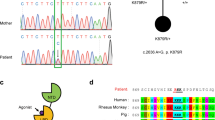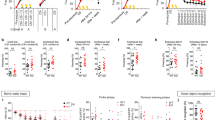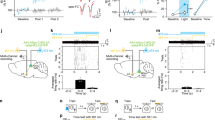Abstract
In addition to its central role in learning and memory, N-methyl D-aspartate receptor (NMDAR)-dependent signaling regulates central glutamatergic synapse maturation and has been implicated in schizophrenia. We have transiently induced NMDAR hypofunction in infant mice during postnatal days 7–11, followed by testing fear memory specificity and presynaptic plasticity in the prefrontal cortex (PFC) in adult mice. We show that transient NMDAR hypofunction during early brain development, coinciding with the maturation of cortical plasticity results in a loss of an endocannabinoid (eCB)-mediated form of long-term depression (eCB-LTD) at adult central glutamatergic synapses, while another form of presynaptic long-term depression mediated by the metabotropic glutamate receptor 2/3 (mGluR2/3-LTD) remains intact. Mice with this selective impairment of presynaptic plasticity also showed deficits in fear memory specificity. The observed deficit in cortical presynaptic plasticity may represent a neural maladaptation contributing to network instability and abnormal cognitive functioning.
Similar content being viewed by others
Log in or create a free account to read this content
Gain free access to this article, as well as selected content from this journal and more on nature.com
or
References
Best AR, Regehr WG (2008). Serotonin evokes endocannabinoid release and retrogradely suppresses excitatory synapses. J Neurosci 28: 6508–6515.
Calabresi P, Maj R, Pisani A, Mercuri NB, Bernardi G (1992). Long-term synaptic depression in the striatum: physiological and pharmacological characterization. J Neurosci 12: 4224–4233.
Caspi A, Moffitt TE, Cannon M, McClay J, Murray R, Harrington H et al (2005). Moderation of the effect of adolescent-onset cannabis use on adult psychosis by a functional polymorphism in the catechol-O-methyltransferase gene: longitudinal evidence of a gene × environment interaction. Biol Psychiatry 57: 1117–1127.
Chen K, Ratzliff A, Hilgenberg L, Gulyas A, Freund TF, Smith M et al (2003). Long-term plasticity of endocannabinoid signaling induced by developmental febrile seizures. Neuron 39: 599–611.
Coyle JT, Tsai G, Goff D (2003). Converging evidence of NMDA receptor hypofunction in the pathophysiology of schizophrenia. Ann N Y Acad Sci 1003: 318–327.
Di Marzo V, Fontana A, Cadas H, Schinelli S, Cimino G, Schwartz JC et al (1994). Formation and inactivation of endogenous cannabinoid anandamide in central neurons. Nature 372: 686–691.
Gerdeman GL, Ronesi J, Lovinger DM (2002). Postsynaptic endocannabinoid release is critical to long-term depression in the striatum. Nat Neurosci 5: 446–451.
Grayson B, Idris NF, Neill JC (2007). Atypical antipsychotics attenuate a sub-chronic PCP-induced cognitive deficit in the novel object recognition task in the rat. Behav Brain Res 184: 31–38.
Haller J, Szirmai M, Varga B, Ledent C, Freund TF (2005). Cannabinoid CB1 receptor dependent effects of the NMDA antagonist phencyclidine in the social withdrawal model of schizophrenia. Behav Pharmacol 16: 415–422.
Hempel CM, Hartman KH, Wang XJ, Turrigiano GG, Nelson SB (2000). Multiple forms of short-term plasticity at excitatory synapses in rat medial prefrontal cortex. J Neurophysiol 83: 3031–3041.
Hsieh C, Brown S, Derleth C, Mackie K (1999). Internalization and recycling of the CB1 cannabinoid receptor. J Neurochem 73: 493–501.
Javitt DC, Zukin SR (1991). Recent advances in the phencyclidine model of schizophrenia. Am J Psychiatry 148: 1301–1308.
Kasanetz F, Lafourcade M, Deroche-Gamonet V, Revest JM, Berson N, Balado E et al (2012). Prefrontal synaptic markers of cocaine addiction-like behavior in rats. Mol Psychiatry 18: 729–737.
Kim J, Isokawa M, Ledent C, Alger BE (2002). Activation of muscarinic acetylcholine receptors enhances the release of endogenous cannabinoids in the hippocampus. J Neurosci 22: 10182–10191.
Korzus E, Rosenfeld MG, Mayford M (2004). CBP histone acetyltransferase activity is a critical component of memory consolidation. Neuron 42: 961–972.
Kreitzer AC, Malenka RC (2007). Endocannabinoid-mediated rescue of striatal LTD and motor deficits in Parkinson's disease models. Nature 445: 643–647.
Lafourcade M, Elezgarai I, Mato S, Bakiri Y, Grandes P, Manzoni OJ (2007). Molecular components and functions of the endocannabinoid system in mouse prefrontal cortex. PLoS One 2: e709.
Leroy S, Griffon N, Bourdel MC, Olie JP, Poirier MF, Krebs MO (2001). Schizophrenia and the cannabinoid receptor type 1 (CB1): association study using a single-base polymorphism in coding exon 1. Am J Med Genet 105: 749–752.
Leutgeb JK, Leutgeb S, Moser MB, Moser EI (2007). Pattern separation in the dentate gyrus and CA3 of the hippocampus. Science 315: 961–966.
Long JZ, Li W, Booker L, Burston JJ, Kinsey SG, Schlosburg JE et al (2009). Selective blockade of 2-arachidonoylglycerol hydrolysis produces cannabinoid behavioral effects. Nat Chem Biol 5: 37–44.
Lovinger DM (2008). Presynaptic modulation by endocannabinoids. Handb Exp Pharmacol 184: 435–477.
Makara JK, Mor M, Fegley D, Szabo SI, Kathuria S, Astarita G et al (2005). Selective inhibition of 2-AG hydrolysis enhances endocannabinoid signaling in hippocampus. Nat Neurosci 8: 1139–1141.
Marr D (1971). Simple memory: a theory for archicortex. Philos Trans R Soc Lond Ser B 262: 23–81.
Marrs WR, Blankman JL, Horne EA, Thomazeau A, Lin YH, Coy J et al (2010). The serine hydrolase ABHD6 controls the accumulation and efficacy of 2-AG at cannabinoid receptors. Nat Neurosci 13: 951–957.
Mato S, Chevaleyre V, Robbe D, Pazos A, Castillo PE, Manzoni OJ (2004). A single in-vivo exposure to delta 9THC blocks endocannabinoid-mediated synaptic plasticity. Nat Neurosci 7: 585–586.
Mato S, Robbe D, Puente N, Grandes P, Manzoni OJ (2005). Presynaptic homeostatic plasticity rescues long-term depression after chronic Delta 9-tetrahydrocannabinol exposure. J Neurosci 25: 11619–11627.
McHugh TJ, Jones MW, Quinn JJ, Balthasar N, Coppari R, Elmquist JK et al (2007). Dentate gyrus NMDA receptors mediate rapid pattern separation in the hippocampal network. Science 317: 94–99.
Morris BJ, Cochran SM, Pratt JA (2005). PCP: from pharmacology to modelling schizophrenia. Curr Opin Pharmacol 5: 101–106.
Morris SH, Knevett S, Lerner EG, Bindman LJ (1999). Group I mGluR agonist DHPG facilitates the induction of LTP in rat prelimbic cortex in vitro. J Neurophysiol 82: 1927–1933.
Nakatani-Pawlak A, Yamaguchi K, Tatsumi Y, Mizoguchi H, Yoneda Y (2009). Neonatal phencyclidine treatment in mice induces behavioral, histological and neurochemical abnormalities in adulthood. Biol Pharm Bull 32: 1576–1583.
Navawongse R, Eichenbaum H (2013). Distinct pathways for rule-based retrieval and spatial mapping of memory representations in hippocampal neurons. J Neurosci 33: 1002–1013.
O’Reilly RC, McClelland JL (1994). Hippocampal conjunctive encoding, storage, and recall: avoiding a trade-off. Hippocampus 4: 661–682.
Pelletier M, Achim AM, Montoya A, Lal S, Lepage M (2005). Cognitive and clinical moderators of recognition memory in schizophrenia: a meta-analysis. Schizophr Res 74: 233–252.
Piomelli D (2003). The molecular logic of endocannabinoid signalling. Nat Rev Neurosci 4: 873–884.
Reichenberg A, Caspi A, Harrington H, Houts R, Keefe RS, Murray RM et al (2010). Static and dynamic cognitive deficits in childhood preceding adult schizophrenia: a 30-year study. Am J Psychiatry 167: 160–169.
Rinaldi-Carmona M, Le Duigou A, Oustric D, Barth F, Bouaboula M, Carayon P et al (1998). Modulation of CB1 cannabinoid receptor functions after a long-term exposure to agonist or inverse agonist in the Chinese hamster ovary cell expression system. J Pharmacol Exp Ther 287: 1038–1047.
Robbe D, Alonso G, Chaumont S, Bockaert J, Manzoni OJ (2002). Role of p/q-Ca2+ channels in metabotropic glutamate receptor 2/3-dependent presynaptic long-term depression at nucleus accumbens synapses. J Neurosci 22: 4346–4356.
Sahay A, Wilson DA, Hen R (2011). Pattern separation: a common function for new neurons in hippocampus and olfactory bulb. Neuron 70: 582–588.
Tamminga CA (1998). Schizophrenia and glutamatergic transmission. Crit Rev Neurobiol 12: 21–36.
Tamminga CA (2013). Psychosis is emerging as a learning and memory disorder. Neuropsychopharmacology 38: 247.
Tamminga CA, Stan AD, Wagner AD (2010). The hippocampal formation in schizophrenia. Am J Psychiatry 167: 1178–1193.
Tulving E (2002). Episodic memory: from mind to brain. Annu Rev Psychol 53: 1–25.
Ujike H, Takaki M, Nakata K, Tanaka Y, Takeda T, Kodama M et al (2002). CNR1, central cannabinoid receptor gene, associated with susceptibility to hebephrenic schizophrenia. Mol Psychiatry 7: 515–518.
Wang C, McInnis J, Ross-Sanchez M, Shinnick-Gallagher P, Wiley JL, Johnson KM (2001). Long-term behavioral and neurodegenerative effects of perinatal phencyclidine administration: implications for schizophrenia. Neuroscience 107: 535–550.
Wiley JL, Buhler KG, Lavecchia KL, Johnson KM (2003). Pharmacological challenge reveals long-term effects of perinatal phencyclidine on delayed spatial alternation in rats. Prog Neuropsychopharmacol Biol Psychiatry 27: 867–873.
Xu W, Morishita W, Buckmaster PS, Pang ZP, Malenka RC, Sudhof TC (2012). Distinct neuronal coding schemes in memory revealed by selective erasure of fast synchronous synaptic transmission. Neuron 73: 990–1001.
Xu W, Sudhof TC (2013). A neural circuit for memory specificity and generalization. Science 339: 1290–1295.
Zammit S, Owen MJ, Evans J, Heron J, Lewis G (2011). Cannabis, COMT and psychotic experiences. Br J Psychiatry 199: 380–385.
Zhang ZW (2004). Maturation of layer V pyramidal neurons in the rat prefrontal cortex: intrinsic properties and synaptic function. J Neurophysiol 91: 1171–1182.
Acknowledgements
We thank Alia Bana, Alex Hiroto and Christopher L Hughes for their technical assistance; and David M Lovinger and John Lisman for comments on the manuscript.
Author information
Authors and Affiliations
Corresponding author
Additional information
Supplementary Information accompanies the paper on the Neuropsychopharmacology website
Supplementary information
Rights and permissions
About this article
Cite this article
Lovelace, J., Vieira, P., Corches, A. et al. Impaired Fear Memory Specificity Associated with Deficient Endocannabinoid-Dependent Long-Term Plasticity. Neuropsychopharmacol 39, 1685–1693 (2014). https://doi.org/10.1038/npp.2014.15
Received:
Revised:
Accepted:
Published:
Issue date:
DOI: https://doi.org/10.1038/npp.2014.15
Keywords
This article is cited by
-
Role of the Endocannabinoid System in the Pathophysiology of Schizophrenia
Molecular Neurobiology (2017)



